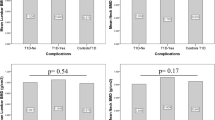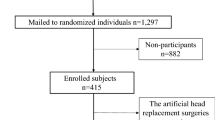Abstract
Bone density, bone turnover and fracture susceptibility were evaluated in 1,132 randomly recruited women, all 75 years old. Seventy-four of the women had diabetes, while 1,058 women did not. Areal bone mineral density (aBMD) of the hip and lumbar spine was investigated by dual energy X-ray absorptiometry (DXA), and bone mass of the calcaneus was measured by ultrasound. Urinary deoxypyridinoline/creatinine (U-DPD/Crea) and serum C-terminal cross-linked telopeptide of type 1 collagen (S-CTX) were assessed as markers of bone resorption. Serum bone-specific alkaline phosphatase (S-bone ALP) and serum osteocalcin (S-OC) were assessed as markers of bone formation. Also, serum 25(OH) vitamin D and serum parathyroid hormone (S-PTH) were assessed. Fracture susceptibility was evaluated retrospectively and prospectively for up to 6.5 years. In diabetic women, the aBMD of the femoral neck was 11% higher ( p <0.001), and BMD of the lumbar spine was 8% higher ( p =0.002) than in non-diabetic women. There was no difference in bone mass by ultrasound of the calcaneus. Women with diabetes had higher BMD of the femoral neck ( p <0.001) and lumbar spine ( p =0.03) also after correction for differences in body weight. In diabetic women, U-DPD/Crea, S-CTX, and S-OC were decreased when compared with non-diabetic women ( p =0.001 or less). After correction for covariance of body weight and plasma creatinine, S-CTX ( p <0.001) and S-OC ( p <0.001) were still lower in the diabetic women. Diabetic patients had hypovitaminosis D ( p =0.008), a difference explained by differences in time spent outdoors and body weight. S-PTH did not differ between the groups. Women with diabetes had no more lifetime fractures (52%) than women without diabetic disease (57%), ( p =0.31). This study shows that elderly women with diabetes and without severe renal insufficiency have high bone mass and low bone turnover. The high bone mass and low bone turnover is not likely to have a strong influence on fracture susceptibility.
Similar content being viewed by others
References
Hampson G, Evans C, Petitt RJ, Evans WD, Woodhead SJ, Peters JR, Ralston SH (1998) Bone mineral density, collagen type 1 alpha 1 genotypes and bone turnover in premenopausal women with diabetes mellitus. Diabetologia 41:1314–1320
Munoz-Torres M, Jodar E, Escobar-Jimenez F, Lopez-Ibarra PJ, Luna JD (1996) Bone mineral density measured by dual X-ray absorptiometry in Spanish patients with insulin-dependent diabetes mellitus. Calcif Tissue Int 58:316–319
Miazgowski T, Czekalski S (1998) A 2-year follow-up study on bone mineral density and markers of bone turnover in patients with long-standing insulin-dependent diabetes mellitus. Osteoporos Int 8:399–403
Jehle PM, Jehle DR, Mohan S, Bohm BO (1998) Serum levels of insulin-like growth factor system components and relationship to bone metabolism in type 1 and type 2 diabetes mellitus patients. J Endocrinol 159:297–306
Gallacher SJ, Fenner JA, Fisher BM, Quin JD, Fraser WD, Logue FC, Cowan RA, Boyle IT, MacCuish AC (1993) An evaluation of bone density and turnover in premenopausal women with type 1 diabetes mellitus. Diabet Med 10:129–133
Weber G, Beccaria L, de’Angelis M, Mora S, Galli L, Cazzuffi MA, Turba F, Frisone F, Guarneri MP, Chiumello G (1990) Bone mass in young patients with type I diabetes. Bone Miner 8:23–30
Krakauer JC, McKenna MJ, Buderer NF, Rao DS, Whitehouse FW, Parfitt AM (1995) Bone loss and bone turnover in diabetes. Diabetes 44:775–782
Tuominen JT, Impivaara O, Puukka P, Ronnemaa T (1999) Bone mineral density in patients with type 1 and type 2 diabetes. Diabetes Care 22:1196–1200
Forst T, Pfutzner A, Kann P, Schehler B, Lobmann R, Schafer H, Andreas J, Bockisch A, Beyer J (1995) Peripheral osteopenia in adult patients with insulin-dependent diabetes mellitus. Diabet Med 12:874–879
Barrett-Connor E, Holbrook TL (1992) Sex differences in osteoporosis in older adults with non-insulin-dependent diabetes mellitus. JAMA 268:3333–3337
el Miedany YM, el Gaafary S, el Baddini MA (1999) Osteoporosis in older adults with non-insulin-dependent diabetes mellitus: is it sex related? Clin Exp Rheumatol 17:561–567
van Daele PL, Stolk RP, Burger H, Algra D, Grobbee DE, Hofman A, Birkenhager JC, Pols HA (1995) Bone density in non-insulin-dependent diabetes mellitus. The Rotterdam Study. Ann Intern Med 122:409–414
Isaia GC, Ardissone P, Di Stefano M, Ferrari D, Martina V, Porta M, Tagliabue M, Molinatti GM (1999) Bone metabolism in type 2 diabetes mellitus. Acta Diabetol 36:35–38
Korpelainen R, Korpelainen J, Heikkinen J, Vaananen K, Keinanen-Kiukaanniemi S (2003) Lifestyle factors are associated with osteoporosis in lean women but not in normal and overweight women: a population-based cohort study of 1,222 women. Osteoporos Int 14:34–43
Schwartz AV, Sellmeyer DE, Ensrud KE, Cauley JA, Tabor HK, Schreiner PJ, Jamal SA, Black DM, Cummings SR (2001) Older women with diabetes have an increased risk of fracture: a prospective study. J Clin Endocrinol Metab 86:32–38
Sosa M, Dominguez M, Navarro MC, Segarra MC, Hernandez D, de Pablos P, Betancor P (1996) Bone mineral metabolism is normal in non-insulin-dependent diabetes mellitus. J Diabetes Complications 10:201–205
Cakatay U, Telci A, Kayali R, Akcay T, Sivas A, Aral F (1998) Changes in bone turnover on deoxypyridinoline levels in diabetic patients. Diabetes Res Clin Pract 40:75–79
Pedrazzoni M, Ciotti G, Pioli G, Girasole G, Davoli L, Palummeri E, Passeri M (1989) Osteocalcin levels in diabetic subjects. Calcif Tissue Int 45:331–336
Cloos C, Wahl P, Hasslacher C, Traber L, Kistner M, Jurkuhn K, Schmidt-Gayk H (1998) Urinary glycosylated, free and total pyridinoline and free and total deoxypyridinoline in diabetes mellitus. Clin Endocrinol (Oxf) 48:317–323
Pietschmann P, Schernthaner G, Woloszczuk W (1988) Serum osteocalcin levels in diabetes mellitus: analysis of the type of diabetes and microvascular complications. Diabetologia 31:892–895
Aksoy H, Akcay F, Kurtul N, Baykal O, Avci B (2000) Serum 1,25 dihydroxy vitamin D (1,25(OH)2D3), 25 hydroxy vitamin D (25(OH)D) and parathormone levels in diabetic retinopathy. Clin Biochem 33:47–51
Ishida H, Suzuki K, Someya Y, Nishimura M, Sugimoto C, Goto M, Taguchi Y, Kasahara H, Kadowaki S, Imura H et al (1993) Possible compensatory role of parathyroid hormone-related peptide on maintenance of calcium homeostasis in patients with non-insulin-dependent diabetes mellitus. Acta Endocrinol (Copenh) 129:519–524
Thomas MK, Lloyd-Jones DM, Thadhani RI, Shaw AC, Deraska DJ, Kitch BT, Vamvakas EC, Dick IM, Prince RL, Finkelstein JS (1998) Hypovitaminosis D in medical inpatients. N Engl J Med 338:777–783
Ottenbacher KJ, Ostir GV, Peek MK, Goodwin JS, Markides KS (2002) Diabetes mellitus as a risk factor for hip fracture in Mexican-American older adults. J Gerontol A Biol Sci Med Sci 57:M648–653
Forsen L, Meyer HE, Midthjell K, Edna TH (1999) Diabetes mellitus and the incidence of hip fracture: results from the Nord-Trondelag Health Survey. Diabetologia 42:920–925
Kelsey JL, Browner WS, Seeley DG, Nevitt MC, Cummings SR (1992) Risk factors for fractures of the distal forearm and proximal humerus. The Study of Osteoporotic Fractures Research Group. Am J Epidemiol 135:477–489
Reid IR (2002) Relationships among body mass, its components, and bone. Bone 31:547–555
Parikh SJ, Edelman M, Uwaifo GI, Freedman RJ, Semega-Janneh M, Reynolds J, Yanovski JA (2004) The relationship between obesity and serum 1,25-dihydroxy vitamin D concentrations in healthy adults. J Clin Endocrinol Metab 89:1196–1199
Nicodemus KK, Folsom AR (2001) Type 1 and type 2 diabetes and incident hip fractures in postmenopausal women. Diabetes Care 24:1192–1197
Jonsson B (1993) Life style and fracture risk. Thesis. Department of Orthopaedics, Malmö University Hospital, Lund University, Malmö, Sweden
Author information
Authors and Affiliations
Corresponding author
Rights and permissions
About this article
Cite this article
Gerdhem, P., Isaksson, A., Åkesson, K. et al. Increased bone density and decreased bone turnover, but no evident alteration of fracture susceptibility in elderly women with diabetes mellitus. Osteoporos Int 16, 1506–1512 (2005). https://doi.org/10.1007/s00198-005-1877-5
Received:
Accepted:
Published:
Issue Date:
DOI: https://doi.org/10.1007/s00198-005-1877-5




